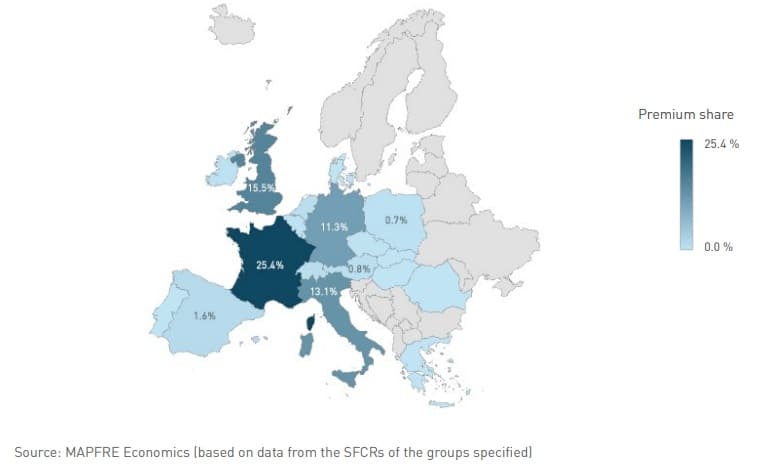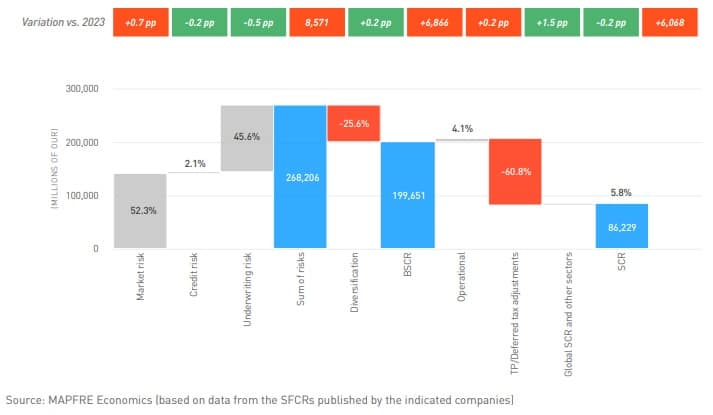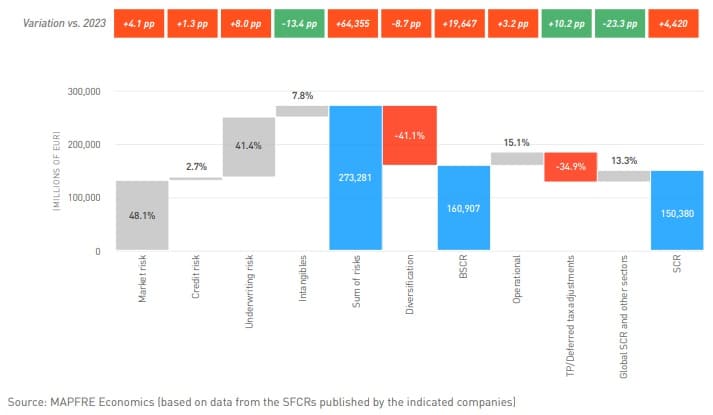Latin America, density, inflation, penetration, monetary policy, forecast, premiums, deepening, Non-life segment, Life segment
Author: MAPFRE Economics
Summary of the conclusiones of the
MAPFRE Economics report
Premiums and Solvency Ratios of the Main European Insurance Groups
Madrid, Fundación MAPFRE, September 2025
Overview of the analysis
Overall, the premium volume of the 20 largest European insurance groups showed steady growth over the 2022–2024 period. According to the Solvency and Financial Condition Reports (SFCR) required under the Solvency II framework, total premiums for the main European insurance groups came to 882.4 billion euros in 2024 (+10.28%), compared to 800.2 billion in 2023 (+2.24%). By major business segment, Life insurance premiums amounted to 518.0 billion euros (+12.05%) in 2024, while Non-Life insurance premiums came to 364.5 billion euros (+7.85%).
From a geographical perspective, France consolidated its position as the country with the highest volume of premiums written by the top 20 European insurance groups—both within its domestic market and across their five largest non-domestic markets—leading in total premiums as well as in the Life segment. Its share grew steadily between 2022 and 2024, increasing from 23.91% to 25.41% of total premiums (see Charts 1 and 2). In the Non-Life sector, after the group of countries categorized under “Other” (which accounted for 24.4% in 2024), France ranked second with a 21.1% share that year.
Chart 1. Total market: geographic distribution in Europe of total premiums of the main European insurance groups in 2024
Chart 2. Total market: geographic distribution outside Europe of the total premiums
of the main European insurance groups in 2024
Elsewhere, the “Other non-domestic markets” section of Table 1 includes, for each insurance group, the premiums corresponding to markets that are neither part of the domestic market of each country nor among the five main countries where these groups write their non-domestic premiums. A higher proportion in this category indicates greater geographical diversification of the insurance business, while lower values reflect a higher concentration in priority or local markets. Overall, groups with a larger international presence and a balanced mix of Life and Non-Life businesses tend to show greater resilience to financial and economic cycles, whereas companies with a domestic or specialized focus are more dependent on the macroeconomic and regulatory conditions of their home markets.
Table 1. Premium structure among the European insurance groups analyzed, 2024
Non-domestic business premiums
The United States consolidated its position as the leading international destination for the twenty European insurance groups within their five largest non-domestic markets in 2024 (64.7 billion euros), driven by Allianz and Talanx. This market led in both total premiums and in the Non-Life segment, with notable growth between 2022 and 2024. Italy ranked second in non-domestic business and was the leader in Life insurance, accounting for more than 18% of premiums in this segment, followed by France, which stood out in Life and gained weight in Non-Life. Germany and the United Kingdom are less relevant beyond their borders, reinforcing the strategic importance of the United States, Italy, and France in the international expansion of European insurance.
Solvency ratios
In 2024, the economic backdrop was less favorable for large European insurance groups due to weak growth in Germany, France, and Italy (with Spain proving the exception). Although inflation eased and the ECB started cutting interest rates in June, the normalization of yield curves did not prevent a widespread decline in solvency ratios, especially among companies with a higher concentration in Life insurance. Only three groups—Poste Vita, Legal & General, and MAPFRE—managed to improve their position compared to the previous year (see Table 2).
Table 2.Main financial and solvency figures*, 2024, 2024
(millions of EUR)
In 2024, the aggregate own funds of the main European insurance groups fell to 493 billion euros (from 505.8 billion in 2023), while the Solvency Capital Requirement (SCR) increased to 236.6 billion euros (compared to 227.1 billion in 2023). This resulted in the aggregate solvency ratio dropping from 222.7% to 208.4%, although it remained more than double the regulatory minimum required by Solvency II. This decline can be explained, among other factors, by the negative impact of falling interest rates on the valuation of technical provisions (which increase as discount rates fall), only partially offset by the appreciation of investment portfolios. The net impact depends on the relative duration of assets and liabilities: if liabilities are longer-term, the effect is adverse. Another important factor was the rise in French sovereign debt risk premiums, which negatively affected the own funds of more exposed companies, as well as the progressive phasing out of transitional measures linked to the implementation of the Solvency II framework in some countries. Even so, capitalization levels remain well above the regulatory requirements, reflecting the sector’s structural strength and the prudent risk management approach applied by these companies.
In comparative terms, significant differences persisted among groups. Poste Vita recorded the highest solvency ratio in the sample (322.6%), followed by Vienna Insurance Group (260.7%), Groupama (241.2%), HDI/Talanx (232.4%), Allianz (227.1%), and Generali (221.5%). At the opposite end of the spectrum, companies more specialized in Life insurance or with more leveraged capital structures registered tighter levels, although in all cases above 150%, a margin considered comfortable by the supervisory authorities.
An aggregate analysis of the capital structure shows that eligible own funds amounted to 493 billion euros in 2024, 2.5% less than in 2023, while the total Solvency Capital Requirement (SCR) increased by 4.2% to 236.6 billion euros. This combination explains the overall reduction in the average coverage ratio. Covéa and MAPFRE recorded the highest relative weight of own funds compared with technical provisions in 2024 (33.6% and 33.0%, respectively) and compared to assets (23.4% and 20.4%).
Regarding the capital composition, Tier 1 accounted for 84.1% of the total, Tier 2 for 14.3%, and Tier 3 for 1.6%, indicative of a high-quality, stable structure (see Table 3).
Table 3. Quality of eligible own funds, 2024
The transitional and adjustment measures of Solvency II aim to mitigate the framework’s impact on insurers. The main measure is the transitional measure on technical provisions, which allows differences with Solvency I to be deferred until 2032. In 2024, six groups (Generali, Aviva, VIG, Legal & General, Groupama, and BCPE) applied this measure, while others, such as Allianz, HDI, R+V, and MAPFRE, discontinued its use. In addition, the volatility adjustment corrects the discount rate to account for market fluctuations, and the matching adjustment allows the discount curve to be adapted when assets and liabilities are aligned in duration.
In 2024, there were significant differences in the composition of the Solvency Capital Requirement (SCR) depending on the calculation method used by European insurance groups. Among those applying the standard formula, a slight increase was observed in the weight of market risk (+0.7 pp), while underwriting and credit risks decreased (-0.5 pp and -0.2 pp, respectively). There was also an additional positive diversification effect (+0.2 pp) and an improvement in the loss-absorbing capacity adjustments of technical provisions and deferred taxes, which reduced the aggregate Basic Solvency Capital Requirement (BSCR) by 60.8% (+1.5 pp). These changes reflect more efficient financial risk management within this group (see Chart 3).
Chart 3. Relative weight of the different components of the SCR
for groups that use the standard formula in 2024 and variation vs. 2023
(millions of euros and percentages)
As shown in Chart 4, the groups using partial or full internal models experienced more notable variations: market risk increased by 4.1 pp and underwriting risk by 8.0 pp, while the “other risks” component decreased significantly (-13.4 pp). Although market risk increased more among groups using internal models (+4.1 pp) than among those applying the standard formula (+0.7 pp), its total weight remains higher under the standard formula, at 52.3% compared to 48.1% for internal models. A decrease was also observed in diversification profits (-8.7 pp), implying a smaller overall reduction in the total capital requirement and an increase in operational risk (+3.2 pp). Finally, loss-absorbing capacity adjustments increased by 10.2 pp, although in this case they only reflect the modeled effects not incorporated into other components of the SCR. Taken together, these variations illustrate how the choice of calculation method influences capital structure and sensitivity to different types of risk.
Chart 4.Relative weight of the different components of the SCR
for groups that use partial internal models in 2024 and variation vs. 2023
(millions of euros and percentages)
The full analysis of the evolution of premiums and solvency levels in the European insurance industry can be found in the report Premiums and Solvency Ratios of the Main European Insurance Groups, prepared by MAPFRE Economics, available at the following link:











